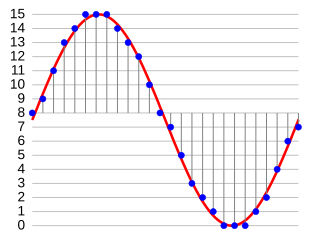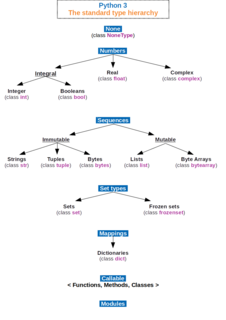This page is based on this
Wikipedia article Text is available under the
CC BY-SA 4.0 license; additional terms may apply.
Images, videos and audio are available under their respective licenses.
An audio file format is a file format for storing digital audio data on a computer system. The bit layout of the audio data is called the audio coding format and can be uncompressed, or compressed to reduce the file size, often using lossy compression. The data can be a raw bitstream in an audio coding format, but it is usually embedded in a container format or an audio data format with defined storage layer.
The Au file format is a simple audio file format introduced by Sun Microsystems. The format was common on NeXT systems and on early Web pages. Originally it was headerless, being simply 8-bit µ-law-encoded data at an 8000 Hz sample rate. Hardware from other vendors often used sample rates as high as 8192 Hz, often integer multiples of video clock signal frequencies. Newer files have a header that consists of six unsigned 32-bit words, an optional information chunk and then the data.
A codec is a device or computer program for encoding or decoding a digital data stream or signal. Codec is a portmanteau of coder-decoder.
In signal processing, data compression, source coding, or bit-rate reduction involves encoding information using fewer bits than the original representation. Compression can be either lossy or lossless. Lossless compression reduces bits by identifying and eliminating statistical redundancy. No information is lost in lossless compression. Lossy compression reduces bits by removing unnecessary or less important information.

In information technology, lossy compression or irreversible compression is the class of data encoding methods that uses inexact approximations and partial data discarding to represent the content. These techniques are used to reduce data size for storing, handling, and transmitting content. The different versions of the photo of the cat to the right show how higher degrees of approximation create coarser images as more details are removed. This is opposed to lossless data compression which does not degrade the data. The amount of data reduction possible using lossy compression is much higher than through lossless techniques.
MP3 is a coding format for digital audio. Originally defined as the third audio format of the MPEG-1 standard, it was retained and further extended—defining additional bit-rates and support for more audio channels—as the third audio format of the subsequent MPEG-2 standard. A third version, known as MPEG 2.5—extended to better support lower bit rates—is commonly implemented, but is not a recognized standard.

Ogg is a free, open container format maintained by the Xiph.Org Foundation. The creators of the Ogg format state that it is unrestricted by software patents and is designed to provide for efficient streaming and manipulation of high-quality digital multimedia. Its name is derived from "ogging", jargon from the computer game Netrek.
An audio codec is a codec that encodes or decodes audio.
MPEG-1 Audio Layer II or MPEG-2 Audio Layer II is a lossy audio compression format defined by ISO/IEC 11172-3 alongside MPEG-1 Audio Layer I and MPEG-1 Audio Layer III (MP3). While MP3 is much more popular for PC and Internet applications, MP2 remains a dominant standard for audio broadcasting.
Advanced Audio Coding (AAC) is an audio coding standard for lossy digital audio compression. Designed to be the successor of the MP3 format, AAC generally achieves better sound quality than MP3 at the same bit rate. The confusingly named AAC+ (HE-AAC) does so only at low bit rates and less so at high ones.
Transcoding is the direct digital-to-digital conversion of one encoding to another, such as for movie data files, audio files, or character encoding. This is usually done in cases where a target device does not support the format or has limited storage capacity that mandates a reduced file size, or to convert incompatible or obsolete data to a better-supported or modern format.
A container or wrapper format is a metafile format whose specification describes how different elements of data and metadata coexist in a computer file.
In digital video broadcasting (DVB), a data and object carousel is used for repeatedly delivering data in a continuous cycle. Carousels allow data to be pushed from a broadcaster to multiple receivers by transmitting a data set repeatedly in a standard format. A set-top box receiver may tune to the data stream at any time and is able to reconstitute the data into a virtual file system. The carousel may therefore be considered as a transport file system or file broadcasting system that allows data files to be transmitted from the broadcaster to multiple receivers or clients simultaneously.

A content format is an encoded format for converting a specific type of data to displayable information. Content formats are used in recording and transmission to prepare data for observation or interpretation. This includes both analog and digitized content. Content formats may be recorded and read by either natural or manufactured tools and mechanisms.
ISO base media file format defines a general structure for time-based multimedia files such as video and audio.
The identical text is published as ISO/IEC 15444-12.
Pulse-code modulation (PCM) is a method used to digitally represent sampled analog signals. It is the standard form of digital audio in computers, compact discs, digital telephony and other digital audio applications. In a PCM stream, the amplitude of the analog signal is sampled regularly at uniform intervals, and each sample is quantized to the nearest value within a range of digital steps.
A Multimedia database (MMDB) is a collection of related multimedia data. The multimedia data include one or more primary media data types such as text, images, graphic objects animation sequences, audio and video.

An audio coding format is a content representation format for storage or transmission of digital audio. Examples of audio coding formats include MP3, AAC, Vorbis, FLAC, and Opus. A specific software or hardware implementation capable of audio compression and decompression to/from a specific audio coding format is called an audio codec; an example of an audio codec is LAME, which is one of several different codecs which implements encoding and decoding audio in the MP3 audio coding format in software.





